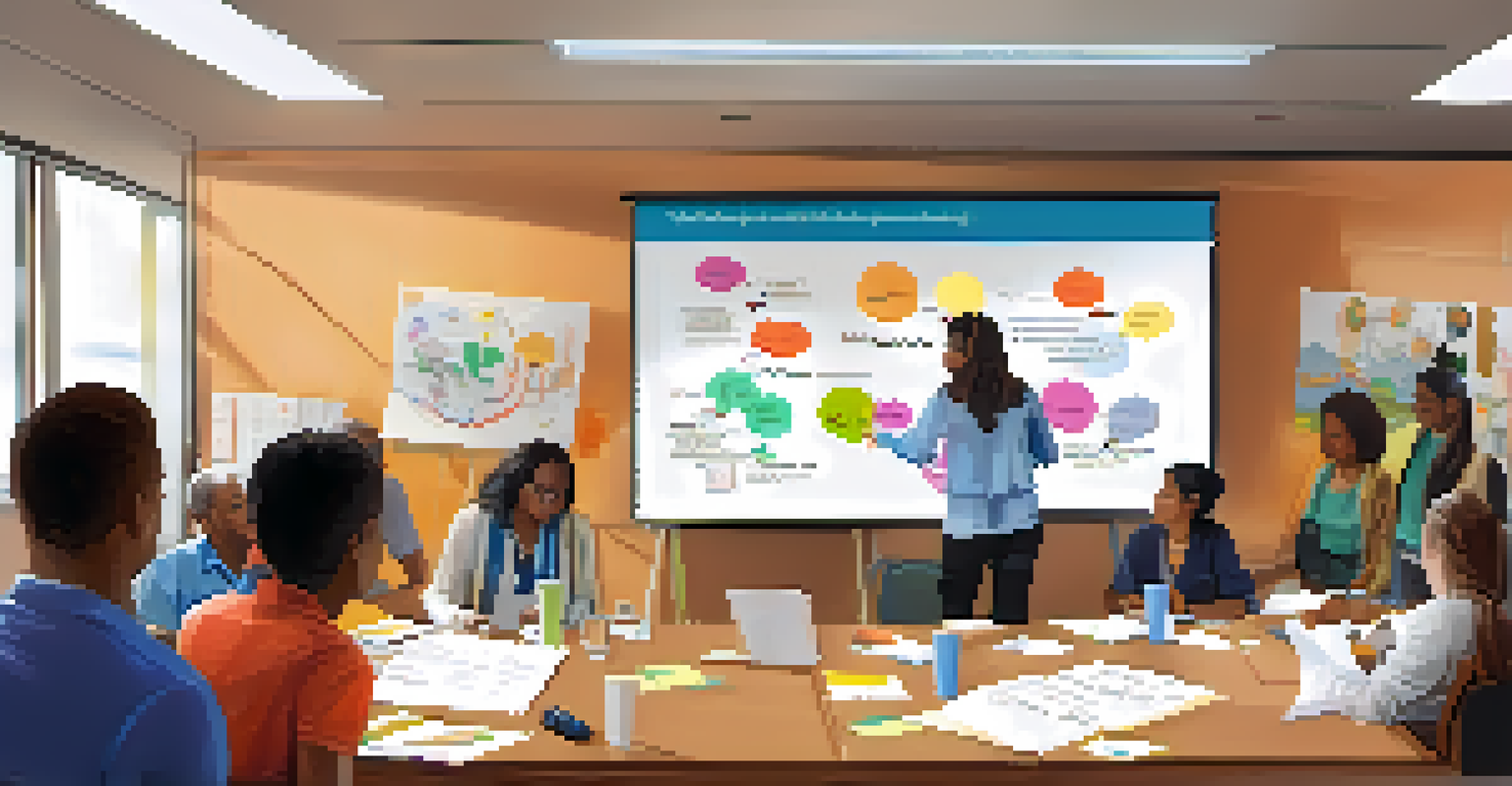Strategies for Conflict Resolution in Collaborative Learning

Understanding the Nature of Conflict in Groups
Conflict in collaborative learning often arises from differing opinions and communication styles. It's essential to recognize that conflict is a natural part of group dynamics, not an obstacle. Understanding the root causes can help participants approach issues more constructively.
Conflict is inevitable, but combat is optional.
For instance, when group members have varying backgrounds, their perspectives may clash. This diversity, while valuable, can lead to misunderstandings that fuel conflict. By acknowledging these differences, teams can foster an environment of respect and open dialogue.
Encouraging team members to express their views can turn potential conflicts into opportunities for growth. By addressing issues early on, groups can create a stronger foundation built on trust and cooperation.
Establishing Clear Communication Channels
Effective communication is crucial in preventing misunderstandings that lead to conflict. Establishing clear channels for sharing ideas and feedback ensures everyone feels heard. Regular check-ins can also promote transparency and reduce frustration among team members.

For example, using collaborative tools like Slack or Trello can streamline communication. These platforms allow groups to share updates and address concerns in real-time, minimizing the chances of miscommunication. When everyone is on the same page, conflicts are less likely to escalate.
Embrace Conflict as Growth
Recognizing conflict as a natural part of group dynamics can turn challenges into opportunities for collaboration and understanding.
Moreover, encouraging active listening practices can significantly enhance communication. By truly hearing each other, group members can address concerns more effectively and collaboratively find solutions.
Setting Common Goals and Objectives
When working in a group, setting common goals provides a shared purpose that unites members. Clear objectives help guide discussions and decision-making processes, reducing the likelihood of conflicts arising from misaligned priorities. Everyone working towards the same target creates a sense of camaraderie.
In the midst of movement and chaos, keep stillness inside of you.
For instance, if a team is tasked with a project, outlining specific milestones can keep everyone focused. When each member understands their role and how it contributes to the overall goal, it fosters collaboration and minimizes friction. This clarity helps prevent arguments over differing agendas.
Additionally, revisiting these goals throughout the collaboration can help maintain alignment. As challenges arise, reflecting on shared objectives can remind the team of their common purpose, helping to diffuse tension and steer discussions back on track.
Encouraging a Culture of Respect and Trust
Building a culture of respect and trust is fundamental to successful collaboration. When team members feel valued and respected, they are more likely to engage positively with one another. This foundation can significantly reduce the occurrence of conflicts, as individuals approach disagreements with a mindset of understanding.
For example, celebrating individual contributions fosters a sense of belonging and appreciation. Recognizing achievements, no matter how small, can strengthen relationships within the group. When people feel acknowledged, they are more inclined to navigate conflicts with empathy.
Communication Prevents Misunderstandings
Establishing clear communication channels and encouraging active listening can significantly reduce the chances of conflict within teams.
Moreover, creating opportunities for team bonding can enhance trust. Activities that promote teamwork outside of project-related tasks allow members to connect personally, making it easier to resolve conflicts when they arise.
Training in Conflict Resolution Techniques
Equipping team members with conflict resolution skills can empower them to handle disputes effectively. Training sessions can introduce techniques such as negotiation, mediation, and active listening. By providing these tools, groups can approach conflicts with confidence rather than fear.
For instance, role-playing scenarios can help members practice resolving conflicts in a safe environment. This hands-on approach not only builds skills but also fosters camaraderie as team members learn together. The more comfortable individuals are with these techniques, the more likely they are to apply them in real situations.
Additionally, ongoing workshops can reinforce these skills over time. As members encounter various conflicts, having a toolkit of strategies can help them navigate challenges more smoothly, leading to a more harmonious collaborative experience.
Utilizing Mediation and Third-Party Support
Sometimes, conflicts can escalate beyond the point where team members can resolve them independently. In such cases, bringing in a neutral third party can help mediate discussions. This mediator can provide an unbiased perspective that facilitates communication and resolution.
For example, a teacher or facilitator can step in during heated discussions, guiding the team toward a constructive dialogue. Their role is to ensure that all voices are heard and that discussions remain respectful. This external support can help de-escalate tensions and find common ground.
Reflect to Learn from Conflicts
Reflecting on resolved conflicts helps teams identify underlying issues and fosters a culture of continuous improvement and resilience.
Moreover, having a mediator allows team members to focus on the issues rather than personal disagreements. This shift in perspective can lead to more productive conversations and ultimately, a resolution that satisfies all parties involved.
Reflecting on and Learning from Conflicts
After resolving a conflict, it's crucial for teams to reflect on the experience. Analyzing what occurred can uncover underlying issues and help prevent similar conflicts in the future. This practice turns conflict into a learning opportunity rather than a setback.
For instance, holding a post-conflict discussion can allow team members to share their feelings about the situation. This open dialogue can lead to insights about individual triggers and group dynamics, fostering a deeper understanding among members. It reinforces the idea that conflict is not inherently negative but can be a valuable part of the collaborative process.

Furthermore, documenting lessons learned can serve as a reference for future collaborations. By having a record of what worked and what didn’t, teams can build a more resilient and cohesive approach to conflict resolution moving forward.